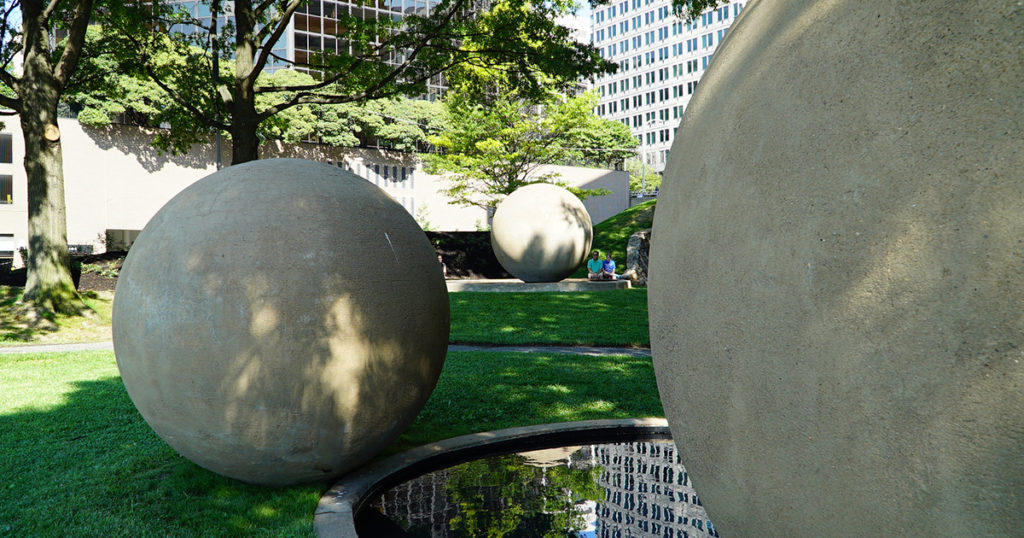
A cantilevered platform will eventually soar over Staten Island’s Freshkills South Park like a giant biplane, offering expansive views to those who venture to the top. It will provide a vista onto a former giant landfill, filled with New York City’s garbage, now being transformed into a public park with bike paths, trails, playgrounds, vegetable gardens, and tidal inlets.
This experiential art installation was designed by Mierle Landerman Ukeles, artist-in-residence for the New York Sanitation Department. Ukeles is one of several women whom art history professor Kirsten Swenson is researching for a book on public art and urban landscape design from the 1970s to the 1990s. She first took an interest in the subject when, as a professor at the University of Nevada, Las Vegas, she encountered Michael Heizer’s and Robert Smithson’s earthworks, large-scale transformations of the rural Southwestern landscape.
“There were many of the same intentions, but what some women in East Coast cities were doing wasn’t called earthworks or land art,” says Swenson, now at the University of Massachusetts Lowell. “They were using the experience of landscape and environment to think about history and land use. They’re seeing landscape architecture as an art form, overseeing and redesigning public spaces. The park itself is a work of art.”
Smithson’s and Heizer’s projects were made possible by funding from private patrons, but the artists Swenson is researching turned to public arts commissions to produce similarly ambitious projects. The process was very different, Swenson explains. “Public art involves negotiation among various stakeholders—arts commissions, city council members, private developers, and the community. And funding can dry up before a project is finished.”
In addition to Ukeles, Swenson is writing about Agnes Denes and the late Nancy Holt, two other artists who rehabilitated and reused derelict sites. Swenson is focusing on Ukeles’s Danehey Park in Cambridge, Massachusetts, Holt’s Dark Star Park in Arlington, Virginia, and Denes’s Wheatfield—A Confrontation, made for Manhattan’s Battery Park City in 1982 and later recreated in other cities around the world.
For Danehey Park, Ukeles recycled 22 tons of glittering glass and mirror fragments into more than half a mile of “glassphalt” paths, which lead to celebratory circular spaces at the top of a former landfill mound. There, one finds a recycled rubber dance floor featuring an image of a galaxy. From the mound, viewers can look out over marshes that Ukeles has created and other park components she has staged, says Swenson. Ukeles calls this experience “ecological theatre.”
In May 1982, environmental artist Agnes Denes planted hard red spring wheat from North Dakota in today’s Battery Park City in lower Manhattan, near the Statue of Liberty. Denes covered the rubble-filled site—a landfill for the construction of the World Trade Centers—with two inches of topsoil, and she and a few volunteers hand–planted the seeds. In the fall, the wheat was harvested. Denes has remade the project near London and Milan.
Nancy Holt created Dark Star Park on a blighted lot in Arlington, Virginia. Completed in 1984, it combines pools of water and a tunnel and spreads over an acre. Swenson says Holt created sight lines for various “sculptural elements” and sundials that are significant for the history of the town and the property itself.
All of these parks can be reached by public transportation. “For these artists, there was a need to make their work accessible,” Swenson says. “They were designing parks on sites of economic segregation,” such as landfills and abandoned, trash-filled lots.
The pandemic upended Swenson’s plans to be at the Huntington Library this coming year, but she’ll continue her research as a Frederick Burkhardt Residential Fellow at the Kluge Center of the Library of Congress over the 2021–22 academic year.

